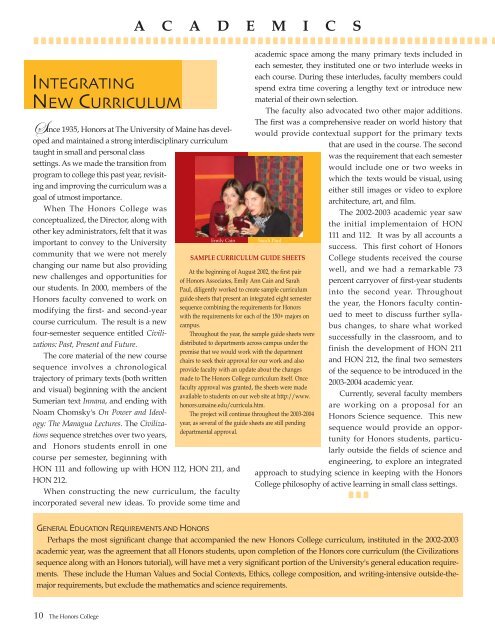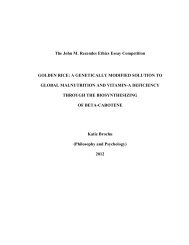MINERVA - Honors College - University of Maine
MINERVA - Honors College - University of Maine
MINERVA - Honors College - University of Maine
You also want an ePaper? Increase the reach of your titles
YUMPU automatically turns print PDFs into web optimized ePapers that Google loves.
Since 1935, <strong>Honors</strong> at The <strong>University</strong> <strong>of</strong> <strong>Maine</strong> has developed<br />
and maintained a strong interdisciplinary curriculum<br />
taught in small and personal class<br />
settings. As we made the transition from<br />
program to college this past year, revisiting<br />
and improving the curriculum was a<br />
goal <strong>of</strong> utmost importance.<br />
When The <strong>Honors</strong> <strong>College</strong> was<br />
conceptualized, the Director, along with<br />
other key administrators, felt that it was<br />
important to convey to the <strong>University</strong><br />
community that we were not merely<br />
changing our name but also providing<br />
new challenges and opportunities for<br />
our students. In 2000, members <strong>of</strong> the<br />
<strong>Honors</strong> faculty convened to work on<br />
modifying the first- and second-year<br />
course curriculum. The result is a new<br />
four-semester sequence entitled Civilizations:<br />
Past, Present and Future.<br />
The core material <strong>of</strong> the new course<br />
sequence involves a chronological<br />
trajectory <strong>of</strong> primary texts (both written<br />
and visual) beginning with the ancient<br />
Sumerian text Innana, and ending with<br />
Noam Chomsky's On Power and Ideology:<br />
The Managua Lectures. The Civilizations<br />
sequence stretches over two years,<br />
and <strong>Honors</strong> students enroll in one<br />
course per semester, beginning with<br />
HON 111 and following up with HON 112, HON 211, and<br />
HON 212.<br />
When constructing the new curriculum, the faculty<br />
incorporated several new ideas. To provide some time and<br />
10 The <strong>Honors</strong> <strong>College</strong><br />
A C A D E M I C S<br />
■ ■ ■ ■ ■ ■ ■ ■ ■ ■ ■ ■ ■ ■ ■ ■ ■ ■ ■ ■ ■ ■ ■ ■ ■ ■ ■ ■ ■ ■ ■ ■ ■ ■ ■ ■ ■ ■ ■ ■ ■ ■ ■ ■ ■ ■ ■ ■ ■ ■ ■ ■ ■ ■ ■ ■ ■ ■ ■ ■ ■ ■<br />
INTEGRATING<br />
NEW CURRICULUM<br />
Emily Cain Sarah Paul<br />
SAMPLE CURRICULUM GUIDE SHEETS<br />
At the beginning <strong>of</strong> August 2002, the first pair<br />
<strong>of</strong> <strong>Honors</strong> Associates, Emily Ann Cain and Sarah<br />
Paul, diligently worked to create sample curriculum<br />
guide sheets that present an integrated eight semester<br />
sequence combining the requirements for <strong>Honors</strong><br />
with the requirements for each <strong>of</strong> the 150+ majors on<br />
campus.<br />
Throughout the year, the sample guide sheets were<br />
distributed to departments across campus under the<br />
premise that we would work with the department<br />
chairs to seek their approval for our work and also<br />
provide faculty with an update about the changes<br />
made to The <strong>Honors</strong> <strong>College</strong> curriculum itself. Once<br />
faculty approval was granted, the sheets were made<br />
available to students on our web site at http://www.<br />
honors.umaine.edu/curricula.htm.<br />
The project will continue throughout the 2003-2004<br />
year, as several <strong>of</strong> the guide sheets are still pending<br />
departmental approval.<br />
academic space among the many primary texts included in<br />
each semester, they instituted one or two interlude weeks in<br />
each course. During these interludes, faculty members could<br />
spend extra time covering a lengthy text or introduce new<br />
material <strong>of</strong> their own selection.<br />
The faculty also advocated two other major additions.<br />
The first was a comprehensive reader on world history that<br />
would provide contextual support for the primary texts<br />
that are used in the course. The second<br />
was the requirement that each semester<br />
would include one or two weeks in<br />
which the texts would be visual, using<br />
either still images or video to explore<br />
architecture, art, and film.<br />
The 2002-2003 academic year saw<br />
the initial implementaion <strong>of</strong> HON<br />
111 and 112. It was by all accounts a<br />
success. This first cohort <strong>of</strong> <strong>Honors</strong><br />
<strong>College</strong> students received the course<br />
well, and we had a remarkable 73<br />
percent carryover <strong>of</strong> first-year students<br />
into the second year. Throughout<br />
the year, the <strong>Honors</strong> faculty continued<br />
to meet to discuss further syllabus<br />
changes, to share what worked<br />
successfully in the classroom, and to<br />
finish the development <strong>of</strong> HON 211<br />
and HON 212, the final two semesters<br />
<strong>of</strong> the sequence to be introduced in the<br />
2003-2004 academic year.<br />
Currently, several faculty members<br />
are working on a proposal for an<br />
<strong>Honors</strong> Science sequence. This new<br />
sequence would provide an opportunity<br />
for <strong>Honors</strong> students, particularly<br />
outside the fields <strong>of</strong> science and<br />
engineering, to explore an integrated<br />
approach to studying science in keeping with the <strong>Honors</strong><br />
<strong>College</strong> philosophy <strong>of</strong> active learning in small class settings.<br />
■ ■ ■<br />
GENERAL EDUCATION REQUIREMENTS AND HONORS<br />
Perhaps the most significant change that accompanied the new <strong>Honors</strong> <strong>College</strong> curriculum, instituted in the 2002-2003<br />
academic year, was the agreement that all <strong>Honors</strong> students, upon completion <strong>of</strong> the <strong>Honors</strong> core curriculum (the Civilizations<br />
sequence along with an <strong>Honors</strong> tutorial), will have met a very significant portion <strong>of</strong> the <strong>University</strong>'s general education requirements.<br />
These include the Human Values and Social Contexts, Ethics, college composition, and writing-intensive outside-themajor<br />
requirements, but exclude the mathematics and science requirements.




